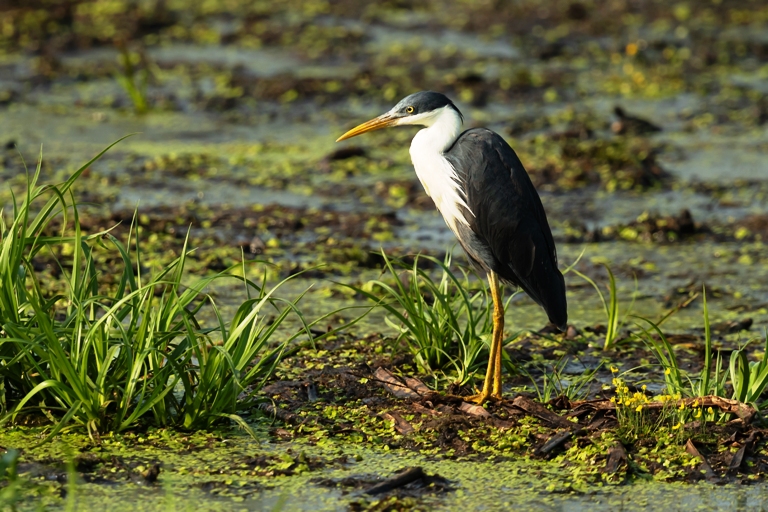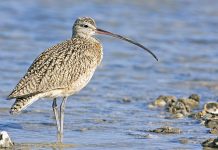Pied herons, or pied egrets (Egretta picata) are exclusively tropical and locally abundant on the coastal flood plains of northern Australia.
They are dainty, gregarious birds and commonly gather in loose feeding groups of 5 to 25 or more on shallow freshwater and saline swamps, wet grassland, and muddied ground churned by stock; even sewage ponds, garbage tips, and meat works are visited.
The bird’s larger aggregations of several hundred or so sometimes congregate around drying lagoons in the dry season. But most of these are white-headed, white-bellied immature of the year. Adults tend to be more solitary and sometimes defend feeding territories of about 50 square meters against others of their species. These are probably the more sedentary breeders.

Their food includes crustaceans, small molluscs, and fish, but insects, their larvae, and nymphs predominate. These herons are often found around buffalo, cattle, horses, pigs, and even poultry. Pied herons capture their prey by walking quickly, gleaning low, and floating vegetation with rapid pecks. Their strike rate is high.
The birds move about more than most herons, pausing less to stand and peer and pecking more frequently. When hunting in deeper water up to 15 centimeters deep, they use the conventional stand-and-wait and stalk slowly strategies, lunging from upright or crouched positions. Pied herons roost and nest colonially.
The sight of hundreds flying silently in random formation upriver to their roosting trees at dusk is impressive. Nesting colonies are usually smaller but often mixed with other species, such as the Intermediate Egret and Little Pied Cormorant. Most colonies have been found in pockets of estuarine mangroves that are flooded at high tide. The nests are built 2 to 5 meters above mud level. It is also known as the Pied Egret or White-headed Egret.

The size of pied herons is about 460–480 mm. Both sexes are similar; however, general plumage is blue-black with white cheeks and neck. Blue-black crest on the back of the head and long blue-black plumes on the back; long white plumes hang down from the base of the neck. The eyes are yellow; there is naked skin in front of the eye, and on the base of the upper mandible, there is dark blue and a yellow bill. Legs and feet dull to orange-yellow.
They are immature as adults, but the entire head, neck, breast, and belly are white; the bend of the wing is white; there are no plumes; and the face skin is yellow-grey. Adult plumage was gained at the end of the first-year molt. The downy young man was patterned as immature, with dusky flanks, olive-grey eyes, and a black bill.
The flight call of Pied Herons is a load of ohrk. Sometimes the call is soft cooing at the nest. Nesting and breeding season over monsoonal summer, mainly January–May. The bird builds a nest platform of sticks and twigs, placed in a tree. Normally, the clutch contains three or four blue-green ellipsoidal eggs, whose size is about 42 x 30 mm.
The distribution of Pied Herons is in saltwater and freshwater coastal swamps and adjacent grasslands in northern Australia; west to the Fitzroy River, Western Australia; and east to the Burdekin system, Queensland. During flood years, a few vagrants reach southeastern Australia. This bird is also found in New Guinea and eastern Indonesia.
Related Reading: Great Blue Heron







